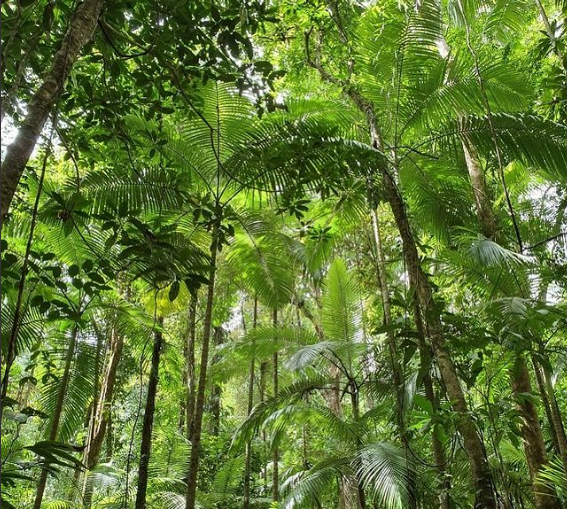We normally imagine a rainy and foggy mornings that clear to sunshine before afternoon thunderstorms and monsoonal rain when we hear the phrase “rain forest.” Rain-forests, on the other hand, are not solely tropical; they may also be found in colder ecosystems at higher elevations and climates, as well as in drier locations that go months without rain.Rain-forests may be found throughout Australia, from the 180-million-year-old Daintree Rain-forest in northern Queensland to the cold, misty temperate rain-forests of Tasmania.
What is a Rain Forest?
Rain-forests are one of the most amazing and interesting natural phenomena. At least half of all living animal and plant species in the world call them home. The diversity of species is unrivaled, particularly in tropical rain-forests. Despite covering just roughly 0.3 percent of Australia, rain-forests are home to half of all Australian plant groups and a third of the country’s animal and bird species.
Various types of Rain Forests in Australia:
Following are the various types of rain-forests in Australia.
- Seasonally drier rain-forest
- humid subtropical rain-forests
- regional wet rain-forests
- littoral (coastal) rain-forests
- and vine forest temperate rain-forests
Australia’s rain-forests are still major and highly ecosystems, despite their shrinking area. They maintain vital landscapes, provide recreation and tourism value, are culturally significant, and provide essential ecological benefits.
Why rain-forests are so important in Australia:
Australia’s rain-forests are home to half of the country’s plant groups, as well as a third of the country’s animal and bird species. Hundreds of rare or endangered plant and animal species call them home.
Source of Motivation and Pleasure:
Rain-forests are a location for recreation and refreshment, as well as a place to study, where people may find quiet, rebirth, and delight in seeing one of the world’s unique settings. Rain-forests inspire artists and craftspeople in a variety of mediums, including poetry, music, construction, art, creative arts, fabric art, ceramics, and flameworking.
Biodiversity:
Australia’s rain-forests are home to half of the country’s plant groups, as well as a third of the country’s animal and bird species. Hundreds of rare species plant and animal species call them home. Scientists continue to make new findings in Australia’s rain-forests, ranging from helpful chemicals released by frogs or discovered in plants to symbiotic relationships between bacteria, fungus, and plants that provide light on ecological processes.
Why we need Rain Forests in Australia:
The rainforest is much more than a gorgeous face! Rainforests perform a practical function in Australia by keeping our world healthy, in addition to the vivid beauty that comes with enormous diversity in flora and animals. By collecting CO2 and releasing oxygen, which is essential for human life.Rainforests also contribute to the global water cycle by releasing water into the atmosphere through evaporation, which results in clouds. Rainforest water is transported all over the world.
Where we can see Rain Forest in Australia:
In Queensland, rainforests may be found in several natural forests. Some parks provide jungle trekking opportunities, while others are only appropriate for experienced hikers.
Why are we concerned about Rain Forests?
They are the planet’s most physically and environmentally varied surface regions. They are biology’s peak. Rainforests formerly filled the whole Australian continent during the Emerald Era. So much of today’s biodiversity, from all kinds of environments, had its origins in these jungles. Here in Australia, we have something truly exceptional. They’ve been reduced to only 0.2 percent of our land, partially because of prior climate change and the browning of our continent, but mostly due to human clearing. Some of the world’s oldest plant and animal lineages may still be found in our jungles. They provide insight into how today’s rich and wonderful diversity arose, spread, and survived.
Biggest Rain Forest in Australia:
The Australian Gondwana Rainforests feature the world’s biggest warm rainforests as well as huge regions of warm and cold temperate rainforest types. From northern New South Wales to south-east Queensland, the rainforests are distributed among 50 distinct parks.
Ways to Protect the Rain Forest:
Strategies for environmental protection are as follows.
- key resources preservation
- maintenance of vital ecological processes
- long-term usage of ecological systems
Where Rain Forest found in Australia:
Tropical region’s rainforests can be found in northern Australia, but they can also be found in southern Australia, as far south as New South Wales. Eastern and southeastern Australia has moderate rain-forests.
The significance of the Native communities:
Indigenous people have a traditional and religious attachment to their homeland. Indigenous people place a high value on land, water, animal, and plant groups. The native presence of rain-forest regions dates back at least 9000 years, according to ancient sites. Rain-forests contain significant sites, many of which are related to geological characteristics, and were exploited as a source of food, medicine, and raw materials.
Importance and Uses:
Rain-forests play a critical role in biodiversity protection. They support a diverse range of woods and woods plant and animal species. Several unique to Australian species, as well as those identified as vulnerable under the Commonwealth Environment Protection and Biodiversity Conservation Act 1999, are included.
Rain-forests make up just 3% of Australia’s total natural forest, yet they are home to 60% of the country’s plant species, 60% of its species of butterflies, 40% of its bird species, and 35% of its animal species.
UNESCO World Heritage Areas include 32 percent of Australia’s rain-forests. They are areas of outstanding natural beauty and aesthetic significance. Their tremendous diversity, as well as their designation as a World Heritage Area, are strong drivers of tourism, ecology, and related economic advantages.
Conclusion:
Rain-forest in Australia plays a vital role. It provides recreation, refreshment, physical and mental peace. Its major advantage is to minimize flooding. Rain-forests provide 20% of Earth’s oxygen which is beneficial for the lungs of the earth. Rain-forests absorb humidity and are an important element of the earth’s lungs. They manage both water and air quality. Rain-forests act as temperature and moisture controllers as well as part of the world’s lungs.Tropical rain-forests, as previously mentioned, play an important role in local climate control through their interactions with water cycles. Rain-forests, on the other hand, have a tremendous impact on world weather.
Travel Talk Tours
- Book any new 2021-22 adventures in Cuba, Peru or Costa Rica and get up to 25% OFF
- Brand new South-East Asia tours are here! Book any 2021 & 2022 tour in Vietnam, Cambodia, Sri Lanka or Myanmar and get up to 25% OFF!
Trusted Tours and Attractions
- Boston Tour and Attraction Discount Tickets
- San Diego Tour and Attraction Discount Tickets
- Travel Gift Certificate
Recommended Reads
- https://thetravelvirgin.com/cute-animals-in-australia/
- https://thetravelvirgin.com/interesting-facts-on-hawaii-top-20/
- https://thetravelvirgin.com/travel-activities/
- https://thetravelvirgin.com/how-fast-can-a-crocodile-run-revealed/
- https://thetravelvirgin.com/lake-hillier-in-australia-all-you-need-to-know/
- https://thetravelvirgin.com/interesting-facts-on-hawaii-top-20/


